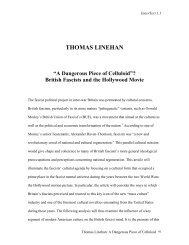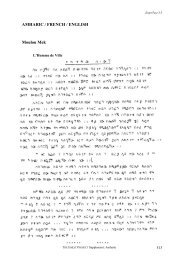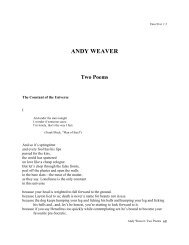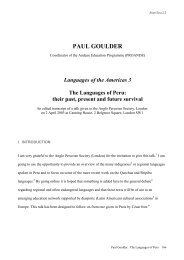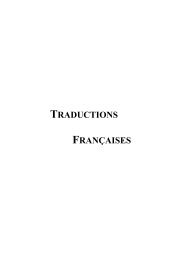Thomas Lamarre: An Introduction to Otaku Movement - Arts @ Brunel
Thomas Lamarre: An Introduction to Otaku Movement - Arts @ Brunel
Thomas Lamarre: An Introduction to Otaku Movement - Arts @ Brunel
You also want an ePaper? Increase the reach of your titles
YUMPU automatically turns print PDFs into web optimized ePapers that Google loves.
EnterText 4.1<br />
Part of the problem is that Azuma sees in Murakami’s art and in anime the arrival<br />
of the postmodern—via a complete rupture with the modern Western gaze.<br />
Unfortunately, by establishing such a his<strong>to</strong>rical and geopolitical rupture, Azuma<br />
recuperates the very gaze that he wishes <strong>to</strong> challenge. 31 Thus he speaks comfortably in<br />
terms that establish Japanese identity. Similarly, Murakami has recently begun <strong>to</strong> speak<br />
of his art <strong>to</strong> date as not really Japanese. He claims <strong>to</strong> have invented this new superflat<br />
lineage within Japanese art for the purposes of international recognition, which would<br />
allow him <strong>to</strong> return <strong>to</strong> Japan <strong>to</strong> pursue his real interests. Not only does he claim <strong>to</strong><br />
manipulate the Western gaze but also he suggests that it is only possible <strong>to</strong> do so by<br />
recourse <strong>to</strong> something authentic. Thus the re-invention of anime becomes a re-invention<br />
of Japaneseness. Indeed, by the late 1990s, there were signs of a nostalgia movement in<br />
the anime industry—remakes of classic series such as Astro Boy, Galaxy Express 999 and<br />
others, precisely those that the Gainax discourse sees as central <strong>to</strong> the definition of anime<br />
—in conjunction with the establishment of anime as national culture.<br />
A similar movement is afoot in North America, in the academy. The field of<br />
Japan Studies has become enthralled with its new object, anime, which promises <strong>to</strong><br />
refresh the study of Japan. 32 <strong>An</strong>ime draws students in<strong>to</strong> the classroom in great numbers,<br />
where (ideally) the professor would then teach them about Japan society and his<strong>to</strong>ry—via<br />
anime. Moreover, many of the introduc<strong>to</strong>ry books on anime read it in terms of national<br />
identity or national allegory. In the words of one author, “anime is, after all, Japan talking<br />
directly <strong>to</strong> itself, reinforcing its cultural myths and preferred modes of behaviour.” 33<br />
<strong>An</strong>other commenta<strong>to</strong>r establishes that “the ‘culture’ <strong>to</strong> which anime belongs is at present<br />
a ‘popular’ or ‘mass’ culture in Japan, and in America it exists as a ‘sub’ culture.” 34 In<br />
<strong>Thomas</strong> <strong>Lamarre</strong>: <strong>Otaku</strong> <strong>Movement</strong> 180



